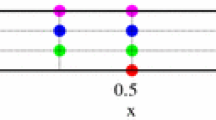Abstract
We present an algorithm to construct meshes suitable for spacetime discontinuous Galerkin finite-element methods. Our method generalizes and improves the ‘Tent Pitcher’ algorithm of Üngör and Sheffer. Given an arbitrary simplicially meshed domain X of any dimension and a time interval [0, T], our algorithm builds a simplicial mesh of the spacetime domain X × [0, T], in constant time per element. Our algorithm avoids the limitations of previous methods by carefully adapting the durations of spacetime elements to the local quality and feature size of the underlying space mesh.








Similar content being viewed by others
References
Abedi R, Chung S-H, Erickson J, Fan Y, Garland M, Guoy D, Haber R, Sullivan JM, Thite S, Zhou Y (2004) Spacetime meshing with adaptive refinement and coarsening. In: Proceedings of the 20th annual ACM symposium on computational geometry, pp 300–309
Bern M, Chew LP, Eppstein D, Ruppert J (1995) Dihedral bounds for mesh generation in high dimensions. In: Proceedings of the 6th annual ACM-SIAM symposium on discrete algorithms, pp 89–196
Bern M, Eppstein D, Gilbert J (1994) Provably good mesh generation. J Comput Syst Sci 48:384–409
Cassidy C, Lord G (1980) A square acutely triangulated. J Rec Math 13(4):263–268
Cheng S-W, Dey TK, Edelsbrunner H, Facello MA, Teng S-H (1999) Sliver exudation. In: Proceedings of the 15th Annual ACM symposium on computational geometry, pp 1–13
Cockburn B, Karniadakis G, Shu C (2000) The development of discontinuous Galerkin methods. In: Discontinuous Galerkin methods: theory, computation and applications. Lecture notes in computer science engineering, vol 11. Springer, Berlin Heidelberg New York, pp 1–14
Cockburn B, Karniadakis G, Shu C (2000) Discontinuous Galerkin methods: theory, computation and applications. Lecture notes in computer science engineering, vol 11. Springer, Berlin Heidelberg New York
Eppstein D (1997) Acute square triangulation. The Geometry Junkyard. http://www.ics.uci.edu/~ eppstein/junkyard/acute-square/
Erickson J, Gouy J, Sullivan J, Üngör A (2002) Building space–time meshes over arbitrary spatial domains. In: Proceedings of the 11th annual international meshing roundtable, pp 391–403. http://www.andrew.cmu.edu/user/sowen/abstracts/Er876.html
Hangan T, Itoh J, (2000) Zamfirescu T Acute triangulations. Bull Math de la Soc des Sci Math de Roumanie 43:279–286
Lowrie RB, Roe PL, van Leer B (1998) Space–time methods for hyperbolic conservation laws. In: Barriers and challenges in computational fluid dynamics. ICASE/LaRC interdisciplinary series in science and engineering, vol 6. Kluwer, Dordrecht, pp 79–98
Maehara H (2000) On acute triangulations of quadrilaterals. In: Proceedings Japan Conference on Discrete Computational Geometry. Lecture notes in computer science, vol 2098. Springer, Berlin Heidelberg New York, pp 237–243. http://link.springer.de/link/service/series/0558/bibs/2098/20980237.htm
Manheimer W (1960) Solution to problem E1406: dissecting an obtuse triangle into acute triangles. Amer Math Monthly 67:923
Richter GR (1994) An explicit finite element method for the wave equation. Appl Numer Math 16:65–80
Ruppert J (1995) A Delaunay refinement algorithm for quality 2-dimensional mesh generation. J Algorithms 18(3):548–585
Sheffer A, Üngör A, Teng S-H, Haber RB (2000) Generation of 2D space–time meshes obeying the cone constraint. Advances in computational engineering and sciences. Tech Science Press, Forsyth, pp 1360–1365
Shewchuk JR (1998) Tetrahedral mesh generation by Delaunay refinement. In: Proceedings of the 14th annual ACM symposium on computational geometry, pp 86–95
Thompson LL (1994) Design and analysis of space–time and Galerkin least-squares finite element methods for fluid-structure interaction in exterior domains. PhD Thesis, Stanford University
Thite S (2004) Efficient spacetime meshing with nonlocal cone constraints. In: Proceedings of the 11th international meshing roundtable, pp 47–58. http://www.andrew.cmu.edu/user/sowen/abstracts/Th997 html
Üngör A (2001) Tiling 3D Euclidean space with acute tetrahedra. In: Proceedings of the 13th Canadian conference on computational geometry, pp 169–172. http://compgeo.math.uwaterloo.ca/~cccg01/proceedings/
Üngör A, Heeren C, Li X, Sheffer A, Haber RB, Teng S-H (2000) Constrained 2D space–time meshing with all tetrahedra. In: Proceedings of the 16th IMACS World Congress
Üngör A, Sheffer A (2000) A pitching tents in space–time: mesh generation for discontinuous Galerkin method. In: Proceedings of the 9th international meshing roundtable, pp 111–122. http://www.andrew.cmu.edu/user/sowen/abstracts/Un738.html
Üngör A, Sheffer A, Haber RB (2000) Space–time meshes for nonlinear hyperbolic problems satisfying a nonuniform angle constraint. In: Proceedings of the 7th international conference on numerical grid generation in computational field simulations
Üngör A, Sheffer A, Haber RB, Teng S-H (2002) Layer based solutions for constrained space-time meshing. To appear in Applied Numer Math. http://www.cse.uiuc.edu/~ungor/abstracts/layerAPNUM.html.
Yin L, Acharya A, Sobh N, Haber R, Tortorelli DA (200) A space–time discontinuous Galerkin method for elastodynamic analysis. In: Discontinuous Galerkin methods: theory, computation and applications. Lecture notes in computer science engineering, vol 11. Springer, Berlin Heidelberg New York, pp 459–464
Acknowledgements
The authors thank David Bunde, Michael Garland, Shripad Thite, and especially Bob Haber for several helpful comments and discussions. We also thank Shripad Thite for correcting a bug in our proof of Lemma 1. Jeff Erickson supported in part by a Sloan Fellowship and NSF CAREER award CCR-0093348. Damrong Gouy supported in part by DOE grant LLNL B341494. John M Sullivan supported in part by NSF grant DMS-00-71520. Alper Üngör This research was performed while this author was a student at the University of Illinois, with the additional support of a UIUC Computational Science and Engineering Fellowship.
Author information
Authors and Affiliations
Corresponding author
Additional information
This work was supported in part by The Center for Process Simulation and Design at the University of Illinois, Urbana-Champaign, under NSF ITR grant DMR-0121695. A preliminary version of this paper was presented at the 11th International Meshing Roundtable [9].
Rights and permissions
About this article
Cite this article
Erickson, J., Guoy, D., Sullivan, J.M. et al. Building spacetime meshes over arbitrary spatial domains. Engineering with Computers 20, 342–353 (2005). https://doi.org/10.1007/s00366-005-0303-0
Received:
Accepted:
Published:
Issue Date:
DOI: https://doi.org/10.1007/s00366-005-0303-0




